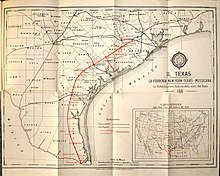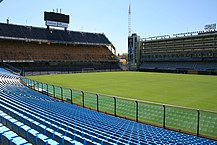BOMT
BOMT | |
| 임상 데이터 | |
|---|---|
| 기타 이름 | Ro 7-2340; 6α-브로모-4-옥사-17α-메틸-5α-디히드로테스토스테론; 6α-브로모-4-옥사-17α-메틸-5α-안드로스탄-17β-ol-3-온 |
| 루트 행정부. | 입으로 |
| 약물 클래스 | 스테로이드 항안드로겐 |
| ATC 코드 |
|
| 식별자 | |
| |
| CAS 번호 |
|
| PubChem CID | |
| 켐스파이더 | |
| CompTox 대시보드 (EPA ) | |
| 화학 및 물리 데이터 | |
| 공식 | C19H29브르O3 |
| 몰 질량 | 385.342 g/120−1 |
| 3D 모델(JSmol) | |
| |
| |
개발 코드명 Ro 7-2340, 6α-브로모-4-옥사-17α-메틸-5α-디하이드로테스토스테론으로도 알려진 BOMT는 합성 스테로이드 항안드로겐으로 1970년에 처음 개발되었으며 의료용으로 [1][2][3][4]시판된 적이 없다.안드로겐 디히드로테스토스테론(DHT)의 6α-브로민화, 4-산소화 및 17α-메틸화 유도체이다.BOMT는 벤로테론, 시프로테론(및 그 C17α 아세테이트 에스테르, 시프로테론 아세테이트), 플루타미드와 [5]함께 개발되어 광범위하게 [2][3][6][7][8]연구된 최초의 항안드로겐 중 하나였지만 다른 [9]것에 비해 잘 문서화되어 있지 않았다.BOMT는 양성 전립선 과형성증 치료에서 임상적으로 조사되었지만, 이 사용을 위한 개발은 [10]계속되지 않았다.여드름, 패턴 탈모, 그리고 아마도 전립선암의 잠재적 적용에 대한 BOMT에 대한 관심도 있었지만,[11] 이러한 징후를 위해 개발되지 않았다.
BOMT는 안드로겐 수용체(AR)[3][4][12][13][14]의 선택적 경쟁 길항제이지만, "상대적으로 약한 경쟁자"[15]로 묘사된다.안드로겐 수용체에 대한 약물의 상대적 결합 친화력은 메트리볼론의 [16]약 2.7%이다.BOMT는 높은 용량에서도 안드로겐성, 에스트로겐성 또는 프로게스토겐성 활성을 보이지 않으며, 5α-환원효소의 [17]억제도 보이지 않지만, 약한 항당향성 [3][4][12][13]효과를 가지고 있는 것으로 보고되었다.BOMT는 AR에 대한 선택성과 경쟁 억제 때문에 벤로테론, 시프로테론 및 플루타미드와 [18]유사하게 순수 또는 "진정한" 항안드로겐으로 설명되어 왔다.다른 스테로이드 항안드로겐과 마찬가지로, BOMT는 특정 [19]상황에서 약한 안드로겐 효과를 가질 가능성이 있는 것으로 보이기 때문에 실제로 AR의 약한 부분 작용제일 수 있다.동물 연구에 따르면, BOMT는 중추신경계 조직에서 AR 길항제 역할을 하지 않으며, 이와 관련하여 시상하부-하수체-선기능 축을 저해하거나 테스토스테론 [20]수치를 증가시키지 않는다.
「 」를 참조해 주세요.
레퍼런스
- ^ J. Elks (14 November 2014). The Dictionary of Drugs: Chemical Data: Chemical Data, Structures and Bibliographies. Springer. pp. 178–. ISBN 978-1-4757-2085-3.
- ^ a b Boris, A.; Uskokovic, M. (1970). "A new antiandrogen. 6α-Bromo-17β-hydroxy-17α-methyl-4-oxa-5α-androstan-3-one". Experientia. 26 (1): 9–10. doi:10.1007/BF01900355. ISSN 0014-4754. PMID 5412314. S2CID 39460337.
[It is shown that 6α-bromo-17β-hydroxy-17α-methyl-4-oxa-5α-androstan-3-one, has significant anti-androgenic activity. Isomers of this compound with different configuration at C-5 and C-6 were found to be inactive.]
- ^ a b c d Boris, Alfred; Demartino, Louis; Trmal, Thelma (1971). "Some Endocrine Studies of a New Antiandrogen, 6 α-Bromo-17β-hydroxy-17α-methyl-4-oxa-5α:-androstan-3-one (BOMT)". Endocrinology. 88 (4): 1086–1091. doi:10.1210/endo-88-4-1086. ISSN 0013-7227. PMID 5542403.
- ^ a b c Mangan, F.R.; Mainwaring, W.I.P. (1972). "An explanation of the antiandrogenic properties of 6α-bromo-17β-hydroxy-17α-methyl-4-oxa-5α-androstane-3-one". Steroids. 20 (3): 331–343. doi:10.1016/0039-128X(72)90092-X. ISSN 0039-128X. PMID 5073580.
- ^ T. Mann; C. Lutwak-Mann (6 December 2012). Male Reproductive Function and Semen: Themes and Trends in Physiology, Biochemistry and Investigative Andrology. Springer Science & Business Media. pp. 352–. ISBN 978-1-4471-1300-3.
- ^ W.I.P. Mainwaring (6 December 2012). The Mechanism of Action of Androgens. Springer Science & Business Media. pp. 10–. ISBN 978-3-642-88429-0.
- ^ Bentham Science Publishers (December 1999). Current Medicinal Chemistry. Bentham Science Publishers. pp. 1110–1111.
Several androstane derivatives have also demonstrated an antiandrogenic activity; 17α-methyl-B-nortestosterone 8 was prepared and tested in 1964 for antihormonal activity [43]. Within the next decades, several other androstane analogs were prepared and found to possess antiandrogenic activity [43, 44, 45, 46] including BOMT 9 "figure 2", R2956 10, SC9420 11, and oxendolone 12 "figure 3".
- ^ Anthony W. Norman; Gerald Litwack (28 June 2014). Hormones. Elsevier Science. pp. 508–. ISBN 978-1-4832-5810-2.
- ^ Clark, C.R.; Nowell, N.W. (1979). "Binding properties of testosterone receptors in the hypothalamic-preoptic area of the adult kale mouse brain". Steroids. 33 (4): 407–426. doi:10.1016/0039-128X(79)90015-1. ISSN 0039-128X. PMID 442132. S2CID 42014129.
However, a less well documented antiandrogen, BOMT possesses the ideal characteristics of negligible androgenic, estrogenic and progestational activity (55) and would therefore appear to be a valuable compound for use in future investigations.
- ^ John Kent; Arthur Bischoff; Harry Herr & William O'Connell (1973), Study of antiandrogen (Ro–7–2340) (6α-bromo-17β-methyl-4-oxa-5α-andronstan-3-one) in benign prostatic hypertrophy
- ^ Bert O'Malley (11 November 2013). Receptors for Reproductive Hormones. Springer Science & Business Media. pp. 208–. ISBN 978-1-4684-3237-4.
- ^ a b Brian Peter Setchell (1978). The mammalian testis. P. Elek. p. 144. ISBN 978-0-236-31057-9.
Another steroidal compound with anti-androgenic activity is BOMT (6α-bromo-17β-hydroxy-17α-methyl-4-oxa-5α-androstan-3-one). This compound has no androgenic, oestrogenic or progestational activity but is a potent anti-androgen (Boris et al., 1970); it competes effectively for the specific, high-affinity binding sites for DHT in the rat prostate (Mangan and Mainwaring, 1972) and depresses testis weight (Boris et al., 1970).
- ^ a b R. J. B. King; W. I. P. Mainwaring (20 May 2014). Steroid–Cell Interactions. Elsevier. pp. 52, 61, 70–71, 300, 401–403. ISBN 978-1-4831-6510-3.
- ^ Singh, Shankar; Gauthier, Sylvain; Labrie, Fernand (2000). "Androgen Receptor Antagonists (Antiandrogens) Structure-Activity Relationships" (PDF). Current Medicinal Chemistry. 7 (2): 211–247. doi:10.2174/0929867003375371. ISSN 0929-8673. PMID 10637363.
- ^ Heyns, W.; G., Verhoeven; De Moor, P. (1976). "Androgen binding in rat uterus cytosol. Study of the specificity". Journal of Steroid Biochemistry. 7 (5): 335–343. doi:10.1016/0022-4731(76)90092-3. ISSN 0022-4731. PMID 180344.
Finally, the steroidal antiandrogen BOMT and the non-steroidal antiandrogen DIMP are only relatively weak competitors.
- ^ Wakeling AE, Furr BJ, Glen AT, Hughes LR (December 1981). "Receptor binding and biological activity of steroidal and nonsteroidal antiandrogens". J. Steroid Biochem. 15: 355–9. doi:10.1016/0022-4731(81)90297-1. PMID 7339263.
- ^ Mangan, F.R.; Mainwaring, W.I.P. (1971). "The Biochemical Basis for the Antagonism hy BOMT of the Effects of Dihydrotesterone on the Rat Ventral Prostate Gland". Gynecologic and Obstetric Investigation. 2 (1–6): 300–304. doi:10.1159/000301871. ISSN 1423-002X. PMID 5161490.
- ^ Tremblay, Roland R. (1986). "10 Treatment of hirsutism with spironolactone". Clinics in Endocrinology and Metabolism. 15 (2): 363–371. doi:10.1016/S0300-595X(86)80030-5. ISSN 0300-595X. PMID 2941190.
Flutamide, cyproterone, benorterone, RU-2956, BOMT and cimetidine are recognized as true antiandrogens because they act as competitive inhibitors of specific ligand binding to androgen receptors.
- ^ Ahlin K, Forsberg JG, Jacobsohn D, Thore-Berger B (1975). "The male genital tract and the nipples of male and female offspring of rats given the non-steroidal antiandrogens DIMP and Sch 13521, during pregnancy". Arch Anat Microsc Morphol Exp. 64 (1): 27–44. PMID 1217898.
- ^ Clark, C.R.; Nowell, N.W. (1979). "Bomt (6α-bromo-17β-hydroxy-17α-methyl-4-oxa-5α-androstan-3-one) is not an androgen antagonist within the central nervous system". Steroids. 34 (2): 139–149. doi:10.1016/0039-128X(79)90043-6. ISSN 0039-128X. PMID 494357. S2CID 54290381.


